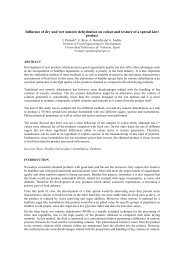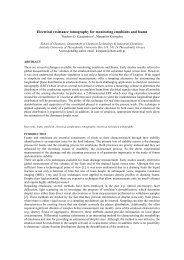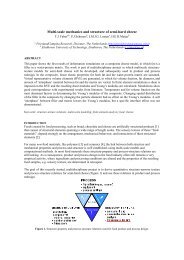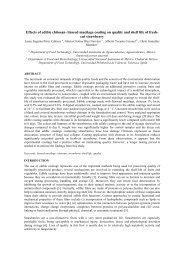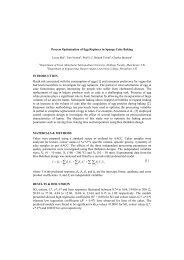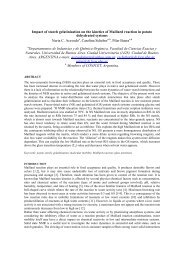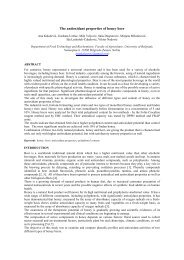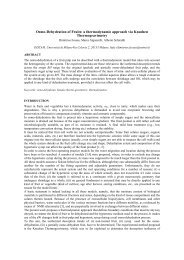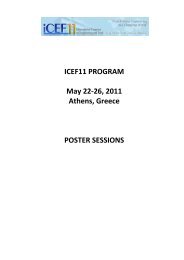Kinetics of Amycolatopsis mediterranei DSM 43304 lipase-mediated ...
Kinetics of Amycolatopsis mediterranei DSM 43304 lipase-mediated ...
Kinetics of Amycolatopsis mediterranei DSM 43304 lipase-mediated ...
You also want an ePaper? Increase the reach of your titles
YUMPU automatically turns print PDFs into web optimized ePapers that Google loves.
<strong>Kinetics</strong> <strong>of</strong> <strong>Amycolatopsis</strong> <strong>mediterranei</strong> <strong>DSM</strong> <strong>43304</strong> <strong>lipase</strong>-<strong>mediated</strong> synthesis <strong>of</strong><br />
isoamyl acetate in n-hexane<br />
Dharmendra S. Dheeman a , Jesús M. Frías a , Gary T.M. Henehan a<br />
a School <strong>of</strong> Food Science & Environmental Health, Dublin Institute <strong>of</strong> Technology (DIT), Cathal Brugha<br />
Street, Dublin 1, Ireland (dheeman@gmail.com, jesus.frias@dit.ie, gary.henehan@dit.ie)<br />
ABSTRACT<br />
Isoamyl acetate is one <strong>of</strong> the most employed esters in food industry because <strong>of</strong> its banana flavour property. A<br />
number <strong>of</strong> commercial <strong>lipase</strong>s have been employed to study kinetics <strong>of</strong> esterification and trans-esterification<br />
in organic solvents to produce isoamyl acetate. However, there are few reports <strong>of</strong> application <strong>of</strong> noncommercial<br />
<strong>lipase</strong>s for the synthesis <strong>of</strong> isoamyl acetate by direct esterification. The present study is the first<br />
report studying the kinetics <strong>of</strong> direct esterification reaction between a short-chain acid and isoamyl alcohol to<br />
synthesize isoamyl acetate using a non-commercial Celite-immobilized <strong>lipase</strong> from <strong>Amycolatopsis</strong><br />
<strong>mediterranei</strong> <strong>DSM</strong> <strong>43304</strong>. The objectives <strong>of</strong> the present wrok were to study the Celite-immobilized A.<br />
<strong>mediterranei</strong> <strong>lipase</strong>-<strong>mediated</strong> kinetics and the effects <strong>of</strong> different parameters on the production <strong>of</strong> isoamyl<br />
acetate through direct esterification in n-hexane. The effects <strong>of</strong> different operating parameters on molar<br />
conversion and initial rates <strong>of</strong> reaction were studied in the absence <strong>of</strong> mass-transfer limitations. The reaction<br />
rate was enhanced by increasing catalyst loading, concentration <strong>of</strong> acetic acid and the operating temperature;<br />
however it was significantly decreased by an excess <strong>of</strong> acetic acid (>0.6 mol L -1 ) and addition <strong>of</strong> water (>1%,<br />
v/v). The optimum parameters for maximum conversion (59%) were found to be an acid/alcohol molar-ratio<br />
<strong>of</strong> 2, a catalyst concentration <strong>of</strong> 7.5% (w/v), and an initial addition <strong>of</strong> 1% (v/v) water at a reaction<br />
temperature <strong>of</strong> 50 °C. A kinetic model based on a postulated multi-substrate Ping Pong Bi Bi mechanism was<br />
proposed to describe the <strong>lipase</strong>-catalyzed direct esterification <strong>of</strong> isoamyl alcohol with acetic acid. Different<br />
simplified kinetic models, derived from the classic Ping Pong Bi Bi mechanism, were fitted by non-linear<br />
regression to the experimental data. Finally, incremental F-tests were performed to assess the simplest model<br />
that was able to provide a statistically good fit throughout the entire time-course <strong>of</strong> the reaction.<br />
Keywords: <strong>Amycolatopsis</strong> <strong>mediterranei</strong>; esterification; isoamyl acetate; kinetic modeling<br />
INTRODUCTION<br />
Isoamyl acetate is one <strong>of</strong> the most widely used esters in the food industry because <strong>of</strong> its characteristic banana<br />
flavour. In the USA alone, more than 74 ton per annum <strong>of</strong> this ester is used [1]. Enzymatic synthesis <strong>of</strong> this<br />
and other aroma active esters is very relevant to the food industry [2]. A number <strong>of</strong> commercial <strong>lipase</strong>s have<br />
been employed for direct esterification and trans-esterification in organic solvent to produce isoamyl acetate<br />
[3-5]. However, few attempts have been made to synthesize isoamyl acetate using non-commercial <strong>lipase</strong>s [6,<br />
7]. Moreover, the ester yields obtained were rather low due to inhibitory effects on the enzymes by shortchain<br />
acids employed [8]. In view <strong>of</strong> this, it is <strong>of</strong> interest to explore the application <strong>of</strong> newly isolated <strong>lipase</strong>s<br />
in the synthesis <strong>of</strong> isoamyl acetate by direct esterification in organic media. In order to identify optimum<br />
conditions for performing ester synthesis, it is important to know reaction kinetics and pertinent rate<br />
constants [9]. Since <strong>lipase</strong>s catalyze multi-substrate and multi-product reactions, their kinetic models, based<br />
on a single substrate Michaelis-Menten model, will be inadequate to provide accurate descriptions <strong>of</strong><br />
prevailing mechanistic phenomena and hence a two step reaction involving Ping Pong Bi Bi mechanism have<br />
been proposed for <strong>lipase</strong> catalyzed reactions in organic media [10-12]. Despite the fact that several kinetic<br />
studies are reported, the information required for process design and optimization <strong>of</strong> reaction under<br />
investigation is limited [4]. Therefore, our aim in the present investigation was to test the performance <strong>of</strong><br />
Celite-immobilized A. <strong>mediterranei</strong> <strong>DSM</strong> <strong>43304</strong> <strong>lipase</strong> for the synthesis <strong>of</strong> isoamyl acetate in n-hexane and<br />
model its kinetics. To this end, Celite-immobilized <strong>lipase</strong> from A. <strong>mediterranei</strong> <strong>DSM</strong> <strong>43304</strong> was employed<br />
to catalyze the direct esterification <strong>of</strong> isoamyl alcohol using acetic acid as an acyl donor. The reactions were<br />
performed in a batch stirred processing set-up using different reaction parameters to optimize initial rates and<br />
conversion yields. Furthermore, the data were fitted by non-linear regression to increasingly simpler<br />
mechanistic models (until a final model was selected), based on the assumptions underlying the Ping Pong Bi<br />
Bi mechanism, and simulation curves were compared with the experimental results to validate the proposed<br />
kinetic model.
MATERIALS & METHODS<br />
Biocatalyst<br />
A. <strong>mediterranei</strong> <strong>DSM</strong> <strong>43304</strong> having high lipolytic activity was screened and optimized for <strong>lipase</strong> production<br />
as described by Dheeman et al. [13]. The extracellular <strong>lipase</strong> from A. <strong>mediterranei</strong> <strong>DSM</strong> <strong>43304</strong> was<br />
immobilized onto Celite matrix and the hydrolytic activity <strong>of</strong> the Celite-immobilized <strong>lipase</strong> was measured<br />
titrimetrically using an olive oil emulsion in 50 mM Tris-HCl buffer (pH 8) at 37 °C [14]. With this assay,<br />
the activity <strong>of</strong> Celite-immobilized <strong>lipase</strong> was 120 IU g -1 . The water content <strong>of</strong> the immobilized enzyme<br />
particles, by comparison <strong>of</strong> weight before and after heating at 105 °C for 12 h, was determined to be 2.2%<br />
(w/w). The same initial batch <strong>of</strong> immobilized <strong>lipase</strong> was used throughout the realization <strong>of</strong> this work.<br />
Esterification reaction<br />
Unless stated otherwise, synthesis <strong>of</strong> isoamyl acetate was carried out in a mechanically agitated glass reactor<br />
with 50 mL capacity. The reactor containing 300 mM <strong>of</strong> isoamyl alcohol and 750 mg Celite-immobilized A.<br />
<strong>mediterranei</strong> <strong>DSM</strong> <strong>43304</strong> <strong>lipase</strong> as a catalyst in n-hexane was placed in a thermostatic water bath providing a<br />
constant temperature to within ±0.1 °C. When the reaction temperature reached the set value (37 °C), acetic<br />
acid was added, to a final concentration <strong>of</strong> 300 mM, to initiate the reaction (total reaction volume 10 mL). A<br />
reaction in the same conditions without enzyme was realized in parallel and was used as a control. All<br />
experiments were performed in duplicate and replicated at least twice. The samples were analyzed on a gas<br />
chromatograph (Perkin Elmer AutoSystem XL, MA, USA) connected to a DB-5 capillary column (30 m ×<br />
0.25 mm, d f 0.25 µm, Agilent JW Scientific, CA, USA) and a flame ionization detector (FID).<br />
Kinetic modeling<br />
For kinetic modeling a total <strong>of</strong> 20 batch experiments were performed providing a total <strong>of</strong> 180 duplicate data<br />
points. Initial reaction rates were obtained from the experimental concentration-time pr<strong>of</strong>iles by regression <strong>of</strong><br />
the linear portion <strong>of</strong> the kinetic data. The experimental concentration pr<strong>of</strong>iles were fitted to the kinetic<br />
models using the Levenberg-Marquardt nonlinear regression algorithm available in the ODRPACK [15]. The<br />
differential equations resulting from the different ester synthesis mechanism simplifications used in the<br />
nonlinear regression was simulated using the ODEPACK library [16].<br />
RESULTS & DISCUSSION<br />
Effect <strong>of</strong> reaction parameters<br />
The effect <strong>of</strong> varying the enzyme loading on the rate <strong>of</strong> reaction was investigated by gradually increasing the<br />
mass <strong>of</strong> enzyme from 0.25 to 1.50 g <strong>of</strong> enzyme (i.e., from 0.83 to 5.0 g <strong>of</strong> enzyme mol -1 <strong>of</strong> the limiting<br />
substrate) at a constant agitation <strong>of</strong> 120 rpm. The results showed that the reaction rate increased linearly with<br />
increased enzyme loading. For the enzymatic synthesis <strong>of</strong> other esters, similar behaviour was found in the<br />
literature [5, 17]. The curves overlapped for larger enzyme loadings (≥5.0 g mol -1 ), suggesting there was no<br />
free substrate to bind with the excess <strong>of</strong> enzyme or external mass transfer resistance was limiting the rate.<br />
Such a rate limitation was also reported for the enzymatic synthesis <strong>of</strong> ethyl palmitate, isoamyl acetate, and<br />
octyl acetate [5, 18, 19]. Since there was no significant increase in rate and conversion with increased<br />
enzyme loadings (>2.5 g mol -1 ), further experiments were performed using enzyme loadings <strong>of</strong> 2.5 g mol -1<br />
(7.5%, w/v).<br />
In the present study, preliminary experiments were performed to ensure the absence <strong>of</strong> external and internal<br />
diffusion limitations in all experiments. The effect <strong>of</strong> speed <strong>of</strong> agitation on initial rate and conversion was<br />
studied over the range <strong>of</strong> 80 to 250 rpm. It was found that both the initial rate and conversion increased with<br />
agitation speeds from 80 to 200 rpm with no significant increase above 200 rpm, indicating the reaction rate<br />
and conversion were no longer limited by mass transfer limitations <strong>of</strong> immobilized enzyme at 200 rpm.<br />
However, above 200 rpm, there was no significant increase in reaction rate and conversion.<br />
In order to assess the influence <strong>of</strong> initial concentration <strong>of</strong> substrates on the reaction kinetics, with the aim<br />
<strong>of</strong>optimizing initial rate and conversion, experiments with different substrate molar ratios were examined.<br />
The enzyme loading (2.5 g mol -1 ) and the concentration <strong>of</strong> isoamyl alcohol were kept constant in this set <strong>of</strong><br />
experiments. The initial rate <strong>of</strong> reaction and equilibrium conversion increased with increasing acetic acid<br />
concentration up to a critical value (600 mM); however, further increase <strong>of</strong> acetic acid concentration above<br />
600 mM, i.e, for an acetic acid/isoamyl alcohol molar ratio >2, resulted in decreased initial rate and<br />
equilibrium conversion. The decreased initial rates and conversion may be due to the formation <strong>of</strong> ineffective<br />
enzyme-substrate complexes at high substrate concentrations [12, 17]. Moreover, polar substrates tend to<br />
accumulate in the micro-queous environment <strong>of</strong> the suspended enzyme and may reach concentration levels
sufficient to cause denaturation <strong>of</strong> the enzyme molecule [20]. The present results are consistent with the<br />
reported inhibition <strong>of</strong> <strong>lipase</strong>s by acetic acid during synthesis <strong>of</strong> esters [7, 21].<br />
Water can have a dramatic influence on biocatalytic processes in non-aqueous media, depending upon the<br />
nature <strong>of</strong> the organic solvent used as a suspension medium [22, 23] and the form <strong>of</strong> enzyme protein<br />
employed [24]. Several mechanisms have been proposed for water-induced enzyme activation in nonaqueous<br />
milieu. It may act as a molecular lubricant, increasing internal flexibility <strong>of</strong> the enzyme [25]<br />
reducing unfavourable protein-protein interactions, responsible for structural distortions and aggregation or it<br />
may increase the active site polarity [23, 24] leading to enhanced enzyme activity in non-aqueous solvents. In<br />
the present study, the initial rate and equilibrium conversion were highest when 100 µL <strong>of</strong> water (1%, v/v)<br />
was added to the reaction mixture under otherwise similar conditions. Water accumulation during the<br />
esterification reaction possibly caused a decrease in the initial rate and equilibrium conversion, when the<br />
amount <strong>of</strong> initially added water was more than 100 µL. Thus, due to its effect on the thermodynamic balance<br />
<strong>of</strong> the reaction, an amount <strong>of</strong> water more than an optimum value (100 µL) resulted in decreased initial rates<br />
and equilibrium conversion indicating that hydrolysis outweighed synthesis (esterification).<br />
Reaction temperature has a pr<strong>of</strong>ound effect on reaction rates, equilibrium conversion and enzyme stability<br />
[19, 26]. However, the effect <strong>of</strong> temperature on equilibrium conversion and initial rate is difficult to predict<br />
because it may influence the reaction efficiency depending on the source <strong>of</strong> the enzyme [26, 27], type <strong>of</strong><br />
immobilization [26] and ionization state <strong>of</strong> the enzyme active site [28]. In accordance with transition state<br />
theory, increasing temperature would result in a positive effect on the rate constant; however, high<br />
temperatures may disrupt enzyme tertiary structure resulting in loss <strong>of</strong> catalytic activity [5]. Therefore, in<br />
view <strong>of</strong> the fact that at temperatures ≥60 °C the immobilized enzyme inactivates faster over the time period<br />
<strong>of</strong> the reaction (72 h) and the boiling point <strong>of</strong> the reaction mixture occurred at 69 °C, the influence <strong>of</strong> the<br />
temperature on the reaction kinetics was investigated in the temperature range <strong>of</strong> 30 to 50 °C. Since Celiteimmobilized<br />
A. <strong>mediterranei</strong> <strong>DSM</strong> <strong>43304</strong> <strong>lipase</strong> is thermostable, ester synthesis was observed at all<br />
temperatures from 30 to 50 °C and the initial rates and equilibrium conversions were found to increase with<br />
the temperature with a maximum rate and equilibrium conversion obtained at 50 °C. This suggests the<br />
predominance <strong>of</strong> kinetic effect in this temperature range [5, 17].<br />
Esterification using optimal parameters<br />
A sequential strategy <strong>of</strong> experimental design proved to be useful in determining the conditions for<br />
maximizing the equilibrium conversion in n-hexane using Celite-immobilized A. <strong>mediterranei</strong> <strong>DSM</strong> <strong>43304</strong><br />
<strong>lipase</strong> as a catalyst. Optimum conversion was obtained at an acetic acid/isoamyl alcohol molar ratio <strong>of</strong> 2,<br />
initial addition <strong>of</strong> 1% (v/v) <strong>of</strong> water and 7.5% (w/v) <strong>of</strong> enzyme (i.e. 2.5 g <strong>of</strong> enzyme mol -1 <strong>of</strong> alcohol) at 50<br />
°C. Under these conditions, a 12 h reaction time was sufficient to reach the equilibrium molar conversion <strong>of</strong><br />
59%; however under non-optimized operational conditions the equilibrium molar conversion reached was<br />
21% after 36 h <strong>of</strong> reaction time (Figure 1). Widely different conversion yields <strong>of</strong> isoamyl acetate in organic<br />
solvent systems have been reported in the literature. Hari Krishna et al. [29] used n- heptane for the synthesis<br />
<strong>of</strong> isoamyl acetate and obtained a conversion yield <strong>of</strong> >80% in 72 h using Rhizomucor miehei Lipozyme IM-<br />
20 at 6.7 g mol -1 <strong>of</strong> substrate, whereas a maximum conversion yield <strong>of</strong> 100% was reported by Romero et al.<br />
[5] using Candida antarctica Novozyme 435 at 13.8 g mol -1 <strong>of</strong> substrate in n-hexane. Liaquat and Owusu<br />
Apenten [30] used n-hexane during esterification to obtain a conversion yield <strong>of</strong> 30% in 48 h with rapeseed<br />
seedling <strong>lipase</strong> at 200 g mol -1 <strong>of</strong> substrate. Furthermore, Larios et al. [31] reported a conversion yield <strong>of</strong> 74%<br />
for the synthesis <strong>of</strong> n-butyl acetate in n-hexane using C. antarctica <strong>lipase</strong> B at 50 g mol -1 <strong>of</strong> substrate. In the<br />
present investigation a non-commercial Celite-immobilized <strong>lipase</strong> at 2.5 g mol -1 <strong>of</strong> substrate was employed to<br />
achieve a conversion yield <strong>of</strong> 59% in 12 h, indicating a significant esterification at a lower enzyme<br />
concentration.<br />
Kinetic model based on time-course measurements<br />
Several studies have reported the kinetic modeling <strong>of</strong> <strong>lipase</strong> <strong>mediated</strong> esterification [10, 12, 32] and transesterification<br />
[17, 33, 34] reactions in organic media using commercially available immobilized <strong>lipase</strong>s.<br />
However no attempt has been made to develop a kinetic model for the direct esterification using a noncommercial<br />
<strong>lipase</strong>. To the best <strong>of</strong> our knowledge the present study is the first report on the development <strong>of</strong> a<br />
kinetic model for direct esterification reaction in organic solvent catalyzed by a non-commercial<br />
actinomycete <strong>lipase</strong>. Esterification reactions <strong>of</strong> various organic acids with different alcohols by a variety <strong>of</strong><br />
commercial <strong>lipase</strong>s are <strong>of</strong>ten modeled using the so called Ping Pong Bi Bi mechanism, a well known and<br />
widely accepted mechanism for <strong>lipase</strong>-catalyzed reactions [9-11, 17]. In the present investigation, the Ping<br />
Pong Bi Bi mechanism coupled with a competitive inhibition by one <strong>of</strong> the substrates was assumed as a basis
for the kinetic model building [10,11]. The description <strong>of</strong> this mechanism and the associated rate (r) is given<br />
by Eq. (1) [35].<br />
⎪⎧<br />
[ ] [ ]<br />
[ ΙΑΑc] × [ Η ] ⎪⎫<br />
2Ο<br />
ν<br />
fν<br />
r ⎨ Αc<br />
× Η<br />
2Ο<br />
−<br />
⎬<br />
⎪⎩<br />
keq<br />
r =<br />
⎪⎭<br />
(1)<br />
⎛<br />
{ [ ] [ ]<br />
[ ΙΑΑ]<br />
⎞ ν<br />
f<br />
km,<br />
Η Ο<br />
ν<br />
f<br />
k<br />
2<br />
m,<br />
ΙΑΑc<br />
ν<br />
⎜<br />
⎟<br />
f<br />
km,<br />
ΙΑΑ<br />
Αc<br />
+ ν<br />
rkm,<br />
Αc<br />
ΙΑΑ × 1 + + [ ΙΑΑc] + [ Η<br />
2Ο] + ν<br />
f<br />
[ Αc] × [ Η2Ο]<br />
⎝ k'<br />
ΙΑΑ ⎠ keq<br />
keq<br />
ν<br />
f<br />
km,<br />
Η Ο<br />
ν<br />
f<br />
ν<br />
rk<br />
2<br />
m,<br />
Αc<br />
+ [ Αc] × [ ΙΑΑc] + [ ΙΑΑc] × [ Η2Ο] + [ ΙΑΑ] × [ Η<br />
2Ο] }<br />
k k<br />
k<br />
k<br />
eq i,<br />
Αc<br />
eq<br />
i,<br />
Η 2Ο<br />
where v f and v r are the maximal velocities for the forward and the reverse reactions, respectively, k eq is the<br />
equilibrium constant, k m,IAA , k m,Ac , k m,H2O and k m,IAAc are the Michaelis-Menten constants for isoamyl alcohol<br />
(IAA), acetic acid (Ac), water (H 2 O) and isoamyl acetate (IAAc), respectively, k’ IAA is the inhibition constant<br />
for IAA, and k i,Ac and k i,H2O are the dissociation constants for Ac and H 2 O from the specific enzyme-inhibitor<br />
complex, respectively.<br />
Owing to the mathematical complexity <strong>of</strong> this full-model involving ten adjustable parameters with associated<br />
problems <strong>of</strong> unidentifiability and indistinguishability <strong>of</strong> different parameters under normal experimental<br />
situations, a strategy to study the effect <strong>of</strong> dropping out some parameter(s) in order to produce a simpler<br />
model was implemented [11, 34]. Following the methodology <strong>of</strong> Paiva et al. [11], the Michaelis-Menten<br />
dissociation constant terms for each <strong>of</strong> the compounds (k m,x , where ‘x’ represents either [Ac], [IAA], [IAAc]<br />
or [H 2 O]) from the enzyme complex were considered for model reduction; the elimination <strong>of</strong> these<br />
parameters from the denominator <strong>of</strong> model rate constant would mean that such parameters assume high<br />
values in respect to the experimental data and there is no evidence <strong>of</strong> saturation in the concentration range<br />
studied or there is no affinity <strong>of</strong> the enzyme to the compound in question. In order to study the adequacy <strong>of</strong><br />
this hypothesis, the model from Segel [35] was reformulated by eliminating the dissociation constants<br />
yielding simpler models. These models were separately fitted to the experimental data and F-tests were<br />
performed on the associated residual sum <strong>of</strong> squares with the aim <strong>of</strong> investigating the statistical likelihood <strong>of</strong><br />
such simplifications. The results obtained in this comparison are presented in Table 1.<br />
Table 1. F-test results for model nesting<br />
Source model SSQ parameters<br />
Model<br />
(NP)<br />
df RSS a df<br />
Extra<br />
(σ) b<br />
Mean<br />
square<br />
(s 2 ) c F<br />
ratio d<br />
P<br />
value<br />
Full model vs. Nested-1<br />
Eq- 1 793.49 10 53 – – 14.97 – –<br />
Eq-2 792.97 4 59 -0.52 6 -0.09 -0.01 0.99<br />
a Residual sum <strong>of</strong> squares is the difference in the SSQ <strong>of</strong> models, b Extra degrees <strong>of</strong> freedom is the difference in the<br />
number <strong>of</strong> model parameters. c Mean square is the residual sum <strong>of</strong> squares divided by degrees <strong>of</strong> freedom (df). d F ratio is<br />
the full model (f) mean square divided by the mean square <strong>of</strong> the nested model (n),<br />
It can be concluded that, at p < 0.05 level <strong>of</strong> statistical significance, the resulting rate expression can be<br />
described by Eq. (2).<br />
⎪⎧<br />
[ ΙΑΑc] × [ Η ] ⎪⎫<br />
2Ο<br />
{( k<br />
cat f<br />
[ Et<br />
]) × ( k<br />
cat r<br />
[ Et<br />
])} × ⎨[ Αc] × [ ΙΑΑ]<br />
−<br />
⎬<br />
⎪⎩<br />
k<br />
eq ⎪⎭<br />
r =<br />
(2)<br />
( k<br />
f<br />
[ Et<br />
])<br />
( k [ ])[ Αc] × [ ΙΑΑ] cat<br />
cat r<br />
Et<br />
+ [ ΙΑΑc] × [ Η<br />
2Ο]<br />
k<br />
The experimental concentration pr<strong>of</strong>iles were modeled using Eq. (2). Experimental points and the simulated<br />
curves obtained with the developed model are shown in Figure 1. The simulated curves follow reasonably<br />
well the experimental points, showing the kinetic model using Eq. (2) is able to describe the entire reaction<br />
progress under conditions <strong>of</strong> equimolar initial substrate concentrations as well as excess <strong>of</strong> one <strong>of</strong> the<br />
substrates (see Figure 1 for prediction and Table 2 for estimated parameters).<br />
eq
Concentration [mmol L -1 ]<br />
300<br />
280<br />
260<br />
240<br />
Non-optimized condition<br />
100<br />
95<br />
90<br />
85<br />
80<br />
60<br />
20<br />
40<br />
15<br />
10<br />
20<br />
5<br />
0<br />
0 20 40 60<br />
0<br />
80<br />
Conversion [%]<br />
Concentration [mmol L -1 ]<br />
Optimized condition<br />
300<br />
250<br />
100<br />
80<br />
200<br />
60<br />
150<br />
100<br />
40<br />
50<br />
20<br />
0<br />
0 20 40 60<br />
0<br />
80<br />
Conversion [%]<br />
Time [h]<br />
Time [h]<br />
Figure 1. Experimental and simulated ester production pr<strong>of</strong>iles. Enzyme loadings: 250 mg (х,▼), 500 mg (∆,▲), 750 mg<br />
(○,●), 1500 mg (□,■). Open symbol: isoamyl alcohol, Filled symbol: isoamyl acetate.<br />
Table 1. Parameter estimates <strong>of</strong> Eq-2 modelling using the kinetic data.<br />
Model parameter Value 95% confidence interval<br />
k<br />
cat , f<br />
[mol h g-1] 6.91×10-1 5.97×10-1 to 7.84×10-1<br />
k<br />
cat , r<br />
[mol h g-1] 2.57×10-1 1.27×10-1 to 3.87×10-1<br />
k<br />
eq<br />
[-] 7.02×10-2 6.37×10-2 to 7.68×10-2<br />
RSS* [(mol L-1)2] 7.92×102<br />
CONCLUSION<br />
R 2 adj 0.99<br />
The present study investigated the direct esterification <strong>of</strong> isoamyl alcohol with acetic acid, in n-hexane, using<br />
a non-commercial Celite-immobilized A. <strong>mediterranei</strong> <strong>lipase</strong>. The selection <strong>of</strong> various reaction parameters<br />
that maximize equilibrium conversion yield at relatively low enzyme concentration was studied in detail.<br />
Optimized conditions for the synthesis <strong>of</strong> isoamyl acetate were 7.5% (w/v) <strong>of</strong> Celite-immobilized <strong>lipase</strong>, an<br />
acid/alcohol molar ratio <strong>of</strong> 2 with an initial addition <strong>of</strong> 1% (v/v) water at 50 °C and 200 rpm. Under these<br />
conditions the equilibrium conversion yield obtained was 59% in 12 h. A simplified model, based on a<br />
postulated Ping Pong Bi Bi mechanism, adequately described the kinetics <strong>of</strong> Celite-immobilized <strong>lipase</strong><br />
catalyzed direct esterification <strong>of</strong> isoamyl alcohol with acetic acid.<br />
REFERENCES<br />
[1] Welsh F.W., Murray W.D., Williams R.E. 1999. Microbiological and enzymatic production <strong>of</strong> flavor and fragrance<br />
chemicals. Critical Reviews in Biotechnology, 9, 105-169.<br />
[2] Eisenmenger M.J. & Reyes-De-Corcuera J.I. 2010. Enhanced synthesis <strong>of</strong> isoamyl acetate using an ionic liquid–<br />
alcohol biphasic system at high hydrostatic pressure. Journal <strong>of</strong> Molecular Catalysis B: Enzymatic, 67, 36-40.<br />
[3] Razafindralambo H., Blecker C., Lognay G., Marlier M., Wathelet J.P., Severin M. 1994. Improvement <strong>of</strong> enzymatic<br />
synthesis yields <strong>of</strong> flavour acetates: the example <strong>of</strong> the isoamyl acetate. Biotechnology Letters, 16, 247-250.<br />
[4] Rizzi M., Stylos P., Rieck A., Reuss M.A. 1992. A kinetic study <strong>of</strong> immobilized <strong>lipase</strong> catalysing the synthesis <strong>of</strong><br />
isoamyl acetate by transesterification in n-hexane. Enzyme & Microbial Technology 14, 709-714.<br />
[5] Romero M.D., Calvo L., Alba C., Daneshfar A., Ghaziaskar H.S. 2005. Enzymatic synthesis <strong>of</strong> isoamyl acetate with<br />
immobilized Candida antarctica <strong>lipase</strong> in n-hexane. Enzyme & Microbial Technolology, 37, 42–48.<br />
[6] Abbas H., Comeau L. 2003. Aroma synthesis by immobilized <strong>lipase</strong> from Mucor sp. Enzyme & Microbial<br />
Technology, 32, 589-595.<br />
[7] Ghamgui H., Karra-Chaâbouni M., Bezzine S., Miled N., Gargouri Y. 2006. Production <strong>of</strong> isoamyl acetate with<br />
immobilized Staphylococcus simulans <strong>lipase</strong> in solvent-free system. Enzyme & Microbial Technology, 38, 788-794.<br />
[8] Hari Krishna S., Prapulla S.G., Karanth N.G. 2000. Enzymatic synthesis <strong>of</strong> isoamyl butyrate using immobilized<br />
Rhizomucor miehei <strong>lipase</strong> in non-aqueous media. J. <strong>of</strong> Industrial Microbioliology & Biotechnology, 25, 147-154.<br />
[9] Oliveira A.C., Rosa M.F., Barros M.R.A., Cabral J.S.M. 2001. Enzymatic esterification <strong>of</strong> ethanol and oleic acid–a<br />
kinetic study. Journal <strong>of</strong> Molecular Catalysis B: Enzymatic, 11, 999-1005.
[10] Kraai G.N., Winkelman J.G.M., de Vries J.G., Heeres H.J. 2008. Kinetic studies on the Rhizomucor miehei <strong>lipase</strong><br />
catalyzed esterification reaction <strong>of</strong> oleic acid with 1-butanol in a biphasic system. Biochemical Eng. J., 41, 87-94.<br />
[11] Paiva A.L., Van Rossum D., Malcata F.X. 2002. <strong>Kinetics</strong> <strong>of</strong> <strong>lipase</strong>-<strong>mediated</strong> synthesis <strong>of</strong> butyl butyrate in n-hexane.<br />
Biocatalysis & Biotransformation, 20, 43-51.<br />
[12] Romero M.D., Calvo L., Alba C., Daneshfar A. 2007. A kinetic study <strong>of</strong> isoamyl acetate synthesis by immobilized<br />
<strong>lipase</strong>-catalyzed acetylation in n-hexane. Journal <strong>of</strong> Biotechnology, 127, 269–277.<br />
[13] Dheeman D.S., Frias J.M., Henehan G.T.M. 2010. Influence <strong>of</strong> cultivation conditions on the production <strong>of</strong> a<br />
thermostable extracellular <strong>lipase</strong> from <strong>Amycolatopsis</strong> <strong>mediterranei</strong> <strong>DSM</strong> <strong>43304</strong>. J. <strong>of</strong> Industrial Microbiology &<br />
Biotechnology, 37, 1-17.<br />
[14] Dheeman D.S., Henehan G.T.M., Frías J.M. 2011. Purification and properties <strong>of</strong> <strong>Amycolatopsis</strong> <strong>mediterranei</strong> <strong>DSM</strong><br />
<strong>43304</strong> <strong>lipase</strong> and its potential in flavour ester synthesis. Bioresource Technology, 102, 3373-3379.<br />
[15] Boggs P.T. & Donaldson J.R. 1989. Algorithm 676 ODRPACK: S<strong>of</strong>tware for weighted orthogonal distance<br />
regression. ACM Transactions on Mathematical S<strong>of</strong>tware, 15, 348-364.<br />
[16] Radhakrishnan K. & Hindmarsh A. 1993. Description and Use <strong>of</strong> LSODE, the Livermor Solver for Ordinary<br />
Differential Equations. Lawrence Livermore National Laboratory report UCRL-ID-113855.<br />
[17] Yadav G.D. & Devi K.M. 2004. Immobilized <strong>lipase</strong> catalysed esterification and transesterification reaction in nonaqueous<br />
media for the synthesis <strong>of</strong> tetrahydr<strong>of</strong>urfuryl butyrate: comparison and kinetic modeling. Chemical<br />
Engineering Science, 59, 373-383.<br />
[18] Kumar R., Madras G., Modak J. 2004. Enzymatic synthesis <strong>of</strong> ethyl palmitate in supercritical carbon dioxide.<br />
Industrial & Engineering Chemistry Research, 43, 1568-1573.<br />
[19] Yadav G.D. & Trivedi A.H. 2003. Kinetic modelling <strong>of</strong> immobilized-<strong>lipase</strong> catalyzed transesterification <strong>of</strong> n-octanol<br />
with vinyl acetate in non-aqueous media. Enzyme & Microbial Technology, 32, 783-789.<br />
[20] Laane C., Boeren S., Vos K., Veeger C. 1987. Rules for optimization <strong>of</strong> biocatalysis in organic solvents.<br />
Biotechnology & Bioengineering, 30, 81-87.<br />
[21] Langrand G., Rondot N., Triantaphylides C., Baratti J. 1990. Short chain flavour esters synthesis by microbial<br />
<strong>lipase</strong>s. Biotechnology Letters, 12, 581-586.<br />
[22] Gorman L.A.S. & Dordick J.S. 1992. Organic solvents strip water <strong>of</strong>f enzymes. Biotech. & Bioeng., 39, 392-397.<br />
[23] Xu Z-F., Affleck R., Wangikar P., Suzawa V., Dordick J.S., Clark D.S. 1994. Transition state stabilization <strong>of</strong><br />
subtilisins in organic media. Biotechnology & Bioengineering, 43, 515-520.<br />
[24] Persson M., Wehtje E., Adlercreutz P. 2002. Factors governing the activity <strong>of</strong> lyophilised and immobilised <strong>lipase</strong><br />
preparations in organic solvents. ChemBioChem, 3, 566-571.<br />
[25] Schmitke J.L., Wescott C.R., Klibanov A.M. 1996. The mechanistic dissection <strong>of</strong> the plunge in enzymatic activity<br />
upon transition from water to anhydrous solvents. Journal <strong>of</strong> the American Chemical Society, 118, 3360-3365.<br />
[26] Chowdary G.V., Ramesh M.N., Prapulla S.G. 2000. Enzymatic synthesis <strong>of</strong> isoamyl isovalerate using immobilized<br />
<strong>lipase</strong> from Rhizomucor miehei: a multivariate analysis. Process Biochemistry, 36, 331-339.<br />
[27] Güvenç A., Kapucu N., Mehmetoğlu Ü. 2002. The production <strong>of</strong> isoamyl acetate using immobilized <strong>lipase</strong>s in a<br />
solvent-free system. Process Biochemistry, 38, 379-386.<br />
[28] Vidinha P., Harper N., Micaelo N.M., Lourenco N.M.T., Gomes Da Silva M.D.R., Cabral J.M.S., Afonso C.A.M.,<br />
Soares C.M., Barreiros S. 2004. Effect <strong>of</strong> immobilization support, water activity, and enzyme ionization state on<br />
cutinase activity and enantioselectivity in organic media. Biotechnology & Bioengineering, 85, 442-449.<br />
[29] Hari Krishna S., Divakar S., Prapulla S.G., Karanth N.G. 2001. Enzymatic synthesis <strong>of</strong> isoamyl acetate using<br />
immobilized <strong>lipase</strong> from Rhizomucor miehei. Journal <strong>of</strong> Biotechnology, 87, 193-201.<br />
[30] Liaquat M. & Owusu Apenten R.K. 2000. Synthesis <strong>of</strong> low molecular weight flavour esters using plant seedling<br />
<strong>lipase</strong>s in organic media. Journal <strong>of</strong> Food Science, 65, 295–299.<br />
[31] Larios A., García H.S., Oliart R.M., Valerio-Alfaro G. 2004. Synthesis <strong>of</strong> flavour and fragrance esters using<br />
Candida antactica <strong>lipase</strong>. Applied Microbiology & Biotechnology, 65, 373-376.<br />
[32] Žnidaršič-Plazl P. & Plazl I. 2009. Modelling and experimental studies on <strong>lipase</strong>-catalyzed isoamyl acetate synthesis<br />
in a microreactor. Process Biochemistry, 44, 1115-1121.<br />
[33] García-Alles L.F. & Gotor V. 1998. Lipase-catalyzed transesterification in organic media: solvent effects on<br />
equilibrium and individual rate constants. Biotechnology & Bioengineering, 59, 685-694.<br />
[34] Oliveira M.V., Rebocho S.F., Ribeiro A.S., Macedo E.A., Loureiro J.M. 2009. Kinetic modelling <strong>of</strong> decyl acetate<br />
synthesis by immobilized <strong>lipase</strong>-catalysed transesterification <strong>of</strong> vinyl acetate with decanol in supercritical carbon<br />
dioxide. Journal <strong>of</strong> Supercritical Fluids, 50, 138-145.<br />
[35] Segel I.H. 1993. Enzyme kinetics–behavior and analysis <strong>of</strong> rapid equilibrium and steady-state enzyme systems. John<br />
Wiley & Sons, New York, p. 606.



